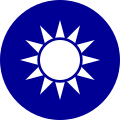 | |
 CBC headquarters; before moving there in the 1970s, the CBC's operations were scattered across various locations in Taipei | |
| Headquarters | Zhongzheng, Taipei |
|---|---|
| Established | 1924 (in Guangzhou) 1928 (in Shanghai) 1949 (in Taipei) |
| Ownership | Executive Yuan of the Central Government of the ROC [1] |
| Governor | Yang Chin-long |
| Central bank of | |
| Currency | New Taiwan Dollar TWD (ISO 4217) |
| Bank rate | 2.0% (13 June 2024) [2] |
| Website | cbc.gov.tw (in English) |
| Central Bank | |||||||||||||||||||||||||
|---|---|---|---|---|---|---|---|---|---|---|---|---|---|---|---|---|---|---|---|---|---|---|---|---|---|
| Traditional Chinese | 中央 銀行 | ||||||||||||||||||||||||
| Simplified Chinese | 中央 银行 | ||||||||||||||||||||||||
| |||||||||||||||||||||||||
The Central Bank of the Republic of China (Taiwan), [3] [4] known from 1924 to 2007 as the Central Bank of China and still referred to under the acronym CBC, [5] is the central bank of Taiwan.
Contents
- History
- Mainland China (1924-1949)
- Taiwan (since 1949)
- Organizational structure
- List of governors
- Access
- See also
- References
- External links
Originally founded in 1924 in Guangzhou,the CBC was expelled from Mainland China by the Chinese Communist Revolution in 1949 and relocated to Taiwan. [6] It took over banknote issuance on the island from the Bank of Taiwan in 1961.
Its legal and common name in Chinese is literally translated as the "Central Bank". The central bank is administered under the Executive Yuan of the ROC government. [7]







